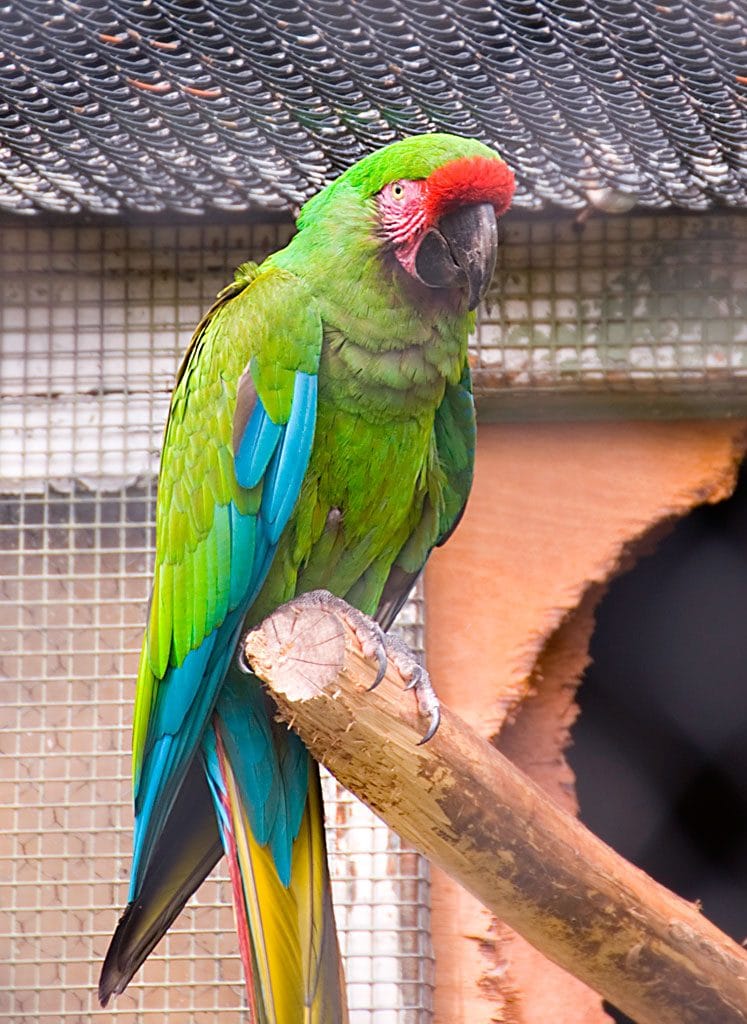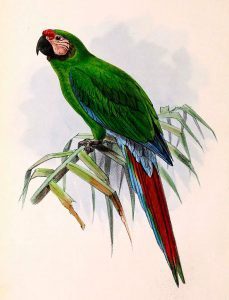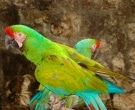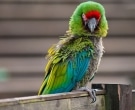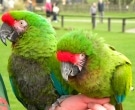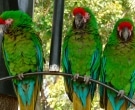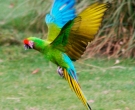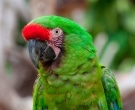Content |
|---|
Description:
70 to 85 cm.. length and a weight between 900 and 1100 g..
The Military Macaw (Ara militaris) has a dark green color. The head is a green slightly clearer and the crown blue. The back and the top of the wings they have a slightly greenish tone. The rounding of the wings, the edge of the wings and flight feather exterior are light blue.
The forecrown it is bright red in color and there are a series of purplish-brown lines of feathers on a background of bare skin, since the nose to behind eyes and in the cheeks.
The area of the throat and a narrow strip below the cheeks are olive brown in colour. Breast and belly green; undertail- coverts pale blue.
Upper, the tail orange-red with the ends of the feathers blue; undertail, the tail olive green yellowish.
The eyes has irises yellow. The bill is dark gray, legs dark grey.
Both sexes similar.
Immature not described but as other large macaws, irises probably Brown, tail shorter and the bare facial skin clearer.
- Sound of the Military Macaw.
Subspecies description:
-
Ara militaris bolivianus
(Reichenow, 1908) – It differs from the species nominal by the throat reddish brown. The headphones feathers they have a base of reddish and blue present in the wings and at the end of the feathers is a more intense tone.
-
Ara militaris mexicanus
(Ridgway, 1915) – Almost identical to the species nominal but larger.
-
Ara militaris militaris
(Linnaeus, 1766) – The nominal species
Habitat:
The Military Macaw they can be mainly observed in foothills of mountainous terrain in woodlands with cannons fields, mostly between 500 and 1, 500 meters above sea level, at the local level to 2.000 m, (3,100 m reported in Peru, to 2,400 m in Bolivia), but also at sea level in the Pacific of Mexico and in the region of Santa Marta, Colombia.
In Mexico, most are distributed in isolated highlands in semi-arid and arid forests, as well as in forests Quercus and Pinus; sometimes in humid, riparian lowland formations, with altitudinal movements to lower altitude to dense scrub forests between November and January.
Observed in humid forests in the Colombian Andes.
In Venezuela, in the rainforest, in some mountainous areas 600 m, sometimes also in more open dry forests.
Usually in pairs or small flocks (until 10 birds), but much larger swarms reported in flights to the roosts. Communal roosts on cliffs or in trees.
Reproduction:
Nest, usually, in crevices of cliffs; sometimes in large trees (for example, Acer, Pinus or Enterolobium).
In Mexico It has been observed to the Military Macaw making use of old nests of the Imperial Woodpecker (Campephilus imperialis) in dead pine.
Breeding pairs are for life.
The egg laying takes place in the month of June in Mexico. They are of two to three eggs that it will take 24 days to hatch, and where the young will remain with the parents for about a year.
The first flights the chicks are produced between the 97 and 140 days old and reach sexual maturity to the 3 or 4 years of age.
Food:
The diet of the Military Macaw It consists of a wide variety of fruits and nuts, including fruit of the Melia azedarach, Ficus and seeds of the Hura crepitans.
Distribution:
Size of the area of distribution (reproduction / resident): 276.000 km2
distributed by Mexico, In addition to several separate populations of South America, heading south to northwest of Argentina.
Widely distributed in Mexico from Sonora (where they have been observed at 28° 45'N) and Chihuahua in the North, until Chiapas, in the South and the East, where the birds may be geographically isolated.
Absent from the lowlands of the Caribbean; ancient appearances in Guatemala not confirmed.
In Colombia to the West of the Andes to the South of Dagua, of the Magdalena River Valley, and on the West side of the Andes, to the East of the Sierra Nevada de Santa Marta, in the North, through the East of the Ecuadorian Andes until Huanuco in the Peruvian Andes.
Also distributed by the North of Venezuela on Serrania del Perija and from Northwest of Zulia until Federal District.
In Peru, mostly, observed in the East of the Andes, above all in the Marañón region, where at least, formerly, It was a common migrant from the slope of the peaceful between September-October(reported on the west slope at 6° 50'S) to feed on the fruit available seasonally.
In the East of the slopes of the the Bolivian Andes, in Santa Cruz de la Sierra, Chuquisaca and Tarija and Northwest corner of Argentina in Salta and possibly Jujuy.
Seasonal movements in many areas, for example, visitors to the West of Caquetá in Colombia, from the western slope of the Andes up to this.
Rare in the South of Mexico (in Chiapas possibly extinct), more numerous in the East and Northwest, where flocks of several hundred birds were reported at the end of 1970.
Very local in the Andes and at risk in Venezuela due to habitat loss and trade.
Fairly common in the North of the region of Santa Marta, but sporadic in other parts of Colombia.
Flocks of up to 60 birds observed in the Manu National Park in Peru and in the Amboró National Park of Bolivia.
Very rare in Argentina with only sporadic reports in recent years. Recent declines due to low habitat and bird trade, a large number of birds in captivity.
Subspecies distribution:
-
Ara militaris bolivianus
(Reichenow, 1908) – South of Bolivia and Northwest of Argentina.
-
Ara militaris mexicanus
(Ridgway, 1915) – Mexico
-
Ara militaris militaris
(Linnaeus, 1766) – The species nominal
Conservation:
• Current Red List of UICN: Vulnerable
• Population trend: Decreasing
The population size is estimated, provisionally, You can be in the band between 10.000 and 20.0000 individuals.
It is suspected that the population This species can be decreasing due to ongoing habitat loss and capture for national trade.
The loss of habitat and especially the national trade they are major threats to this species, even within the reserves (Snyder et to the. 2000).
In 1991-1995, 96 wild-caught specimens were found in the international trade, with Bolivia and Mexico, possibly, major exporters (Chebez 1994, D. Brightsmith in litt., 2007).
In Mexico, remains one of the most sought after species for the illegal trade of birds in cage; between 1995 and 2005, was the fifth country with the most parrots seized by the Environmental Control Agency from the country, becoming the fourth with more seizures between 2007 and 2010 (JC Cantú in litt. 2010).
In many areas it nests in hard-to-reach cavities in cliff faces., that provide some protection against the pressures of plundering of nests. But, the plundering of nests is a serious threat in Jalisco and Nayarit, where the species nests in tree cavities (C. Bonilla in litt. 2007, K. Renton in litt., 2007).
In Jalisco, Mexico, These macaws were not found in deforested areas, even when it was abundant the Hura polyandra (an important source of food), leaving, in the news, as trees to provide shade for cattle (Renton 2004).
An analysis of the GARP believes that the species has undergone a 23% loss of habitat within its distribution area in Mexico (Rios Munoz 2002).
A subpopulation in the Valle del Cauca, Colombia, account for less than 50 mature individuals, little is to be lost as a dam is expected to flood the only nesting cliff (ProAves Foundation 2011).
"Military Macaw" in captivity:
Very popular in poultry.
Although the Macaw Militar is present for more than one century in Europe, He has never enjoyed special interest among the fans, It's a shame, Since it is a being Intelligent. The main reason should be your little flamboyant plumage; especially compared to the one of other macaws. Other failures affect its presence in aviaries: is very loud and has a strong tendency to gnaw.
The power of their vocal organ is much higher than of any other species of Macaw. On the other hand it also good qualities: is very applied to learn, has a great talented imitator and presents an intelligence out of the ordinary.
With regard to its longevity, according to sources, a specimen lived 46 years in captivity. In captivity, these animals have been known that they can raise some 5 years of age.
Alternative names:
– Military Macaw (English).
– Ara militaire (French).
– Soldatenara (German).
– Arara-militar (Portuguese).
– Guacamaya Verde, Guacamayo Militar, Guacamayo Verde, Papagayo verde (español).
– Guacamaya verde oscura (Colombia).
– Guacamayo verde (Venezuela).
– Guacamayo militar (Ecuador).
– Maracan, Paraba militar (Bolivia).
– Jarcia, Sarea (Chaka).
– Panicco (Cofán.).

scientific classification:
– Order: Psittaciformes
– Family: Psittacidae
– Genus: ARA
– Scientific name: Ara militaris
– Citation: (Linnaeus, 1766)
– Protonimo: parrot military
Images Military Macaw:
Videos "Military Macaw"
Sources:
– Avibase
– Parrots of the World – Forshaw Joseph M
– Parrots A Guide to the Parrots of the World – Tony Juniper & Mike Parr
– Birdlife
– Photos:
(1) – Military Macaw (Ara militaris) at London Zoo, England By jon hanson (originally posted to Flickr as military macaw) [CC BY-SA 2.0], via Wikimedia Commons
(2) – Military Macaw Ara militaris in captivity at Occidental Grand Xcaret Resort, Yucatan, Mexico By Tony Hisgett (originally posted to Flickr as Green Parrot) [CC BY 2.0], via Wikimedia Commons
(3) – Military Macaw flying at Whipsnade Zoo, Bedfordshire, England By Ara_militaris_-Whipsnade_Zoo_-flying-8a.jpg: Alex Smithderivative work: Snowmanradio [CC BY 2.0], via Wikimedia Commons
(4) – Three Military Macaws at Zoológico Los Coyotes, Mexico By Gary Denness (originally posted to Flickr as Squawk No Evil) [CC BY 2.0], via Wikimedia Commons
(5) – Two Military Macaws at Whipsnade Zoo, Bedfordshire, England. The macaw on the left has damaged feathers on its chest and abdomen probably because of a feather plucking habit By Mark Fosh (originally posted to Flickr as Macaw) [CC BY 2.0], via Wikimedia Commons
(6) – Two Military Macaws at Moody Gardens, Galveston, Texas, USA By joannapoe (originally posted to Flickr as 2005-06-18_11-52-47) [CC BY-SA 2.0], via Wikimedia Commons
(7) – A Military Macaw at Whipsnade Zoo, Bedfordshire, England. Some of its feathers are damaged probably due to feather plucking By William Warby from London, England (Military MacawUploaded by Snowmanradio) [CC BY 2.0], via Wikimedia Commons
(8) – Military Macaws in Mexico By Gregg (originally posted to Flickr as YOU WANT SOME?) [CC BY-SA 2.0], via Wikimedia Commons
(9) – Military Macaw (Ara militaris). Details of the head and face By Mary Mueller (Flickr) [CC BY 2.0], via Wikimedia Commons
(10) – Arara militaris by John Gerrard Keulemans [Public domain], via Wikimedia Commons
– Sounds: (Xeno-canto)
